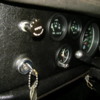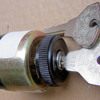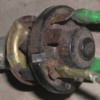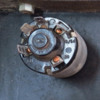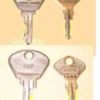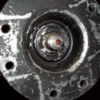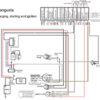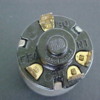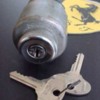A picture of my keys......
Top one is door key, which is definitely a Fiat item (locks anyway) but this is a replacement blank.
There are two original ignition keys below it, the middle one being an original Magneti(sp?) key blank and the bottom one being a replacement blank if memory serves me.
I was always told that the ignition switch for early models (pre-German involvement?) was a Fiat "panel switch" from the 600 and other lines with flat panel dashes. 600 being most prevalent. I looked all over and found nothing. Only recommendations to find a generic switch and be happy.....!
My switch failed in a most dramatic fashion, as I think I outlined years back.....when a piece busted off the inside and fell down and shorted the main hot lead "in" to ground and melted stuff all the way back to the fuse panel. Was not a pretty site. NO FUSE PROTECTION ON THIS WIRE should be noted.....!!!
SO, if you absolutely must run an original switch, as least take the time to orient the switch so that the hot wire "IN" is at the 12:00 position!!! This could save your bazillion dollar car from becoming beer can slag in your garage......
THAT said, before my switch failed, when running my lights, the switch was always VERY HOT to the touch, indicating a bad connection (hindsight is wonderful isn't it!

). When I replaced it with one of Nate's "ugly" switches, the hot switch scenario went away!!!!
I feel a LOT more confident driving my car places now!!!
OK back to original switches. These switches are big POS's.....and the Fiat world has pretty much sucked them all up.
I did purchase one of the Chinese made switches sold by someone in Greece, thru the British eBay site.....world class part right? Nope, world class POS again! The tumbler pattern resembled the profile of a paper clip and the actual switch action was hard and "kachunky" when moved.
Needless to say, I tossed that switch in my box of spare parts and decided that NOTHING is worth putting a BAD part in the car when it is such a CRITICAL PIECE!
What I would suggest perhaps, is coming up with a common switch, and having key blanks stamped to resemble the Morelli Magnetti keys..... or file/cut your key to "resemble" the original style......
Again, biggest thing I can say about this all besides good luck finding an original switch in usable condition, is to orient your switch so that the main hot lead is at the 12:00 position! This may put your key "upside down" perhaps for normal thinkers......but it's the way to go, unless you like watching smoke boil out of your ignition switch and wiring harness......while on the side of the road or anywhere for that matter!
Your choice, please be smart about it!
Cheers!!!
Steve


